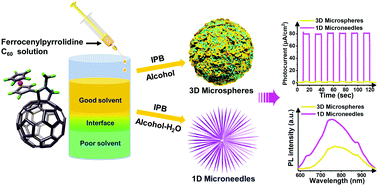From 3D hierarchical microspheres to 1D microneedles: the unique role of water in the morphology control of ferrocenylpyrrolidine C60 microcrystals†
Abstract
Fullerene microcrystals have been well prepared by the conventional liquid–liquid interface precipitation (LLIP) method, and the crystal structures can be manipulated by solvent combination. Aromatic and alcoholic solvents are widely used as good and poor solvents, respectively, in LLIP. However, water with higher polarity has been rarely utilized as a poor solvent for the morphology engineering of fullerenes, particularly in the morphology control of fullerene derivatives. Herein, the water-regulated morphology of a fullerene derivative, namely ferrocenylpyrrolidine C60 (denoted as FC), is investigated via the LLIP method. By simply modulating the combination of a good solvent (aromatic isopropylbenzene, IPB) and the poor solvents (alcohols), three-dimensional (3D) hierarchical microspheres of FC are obtained. Surprisingly, when water is introduced as one of poor solvents in the LLIP process, one-dimensional (1D) microneedles are obtained. The presence of water controls the liquid–liquid interface, the external environment and kinetics of the crystal growth, thereby promoting the morphological evolution from 3D hierarchical microspheres to 1D microneedles. Moreover, the solvated 1D microneedles exhibit enhanced photoluminescence (PL) and photocurrent responses in virtue of the highly ordered molecule arrangement and solvent (IPB) embedding in the crystal lattice. The water-regulated morphology engineering of FC provides a new strategy for the growth and morphology control of fullerene microcrystals.



 Please wait while we load your content...
Please wait while we load your content...